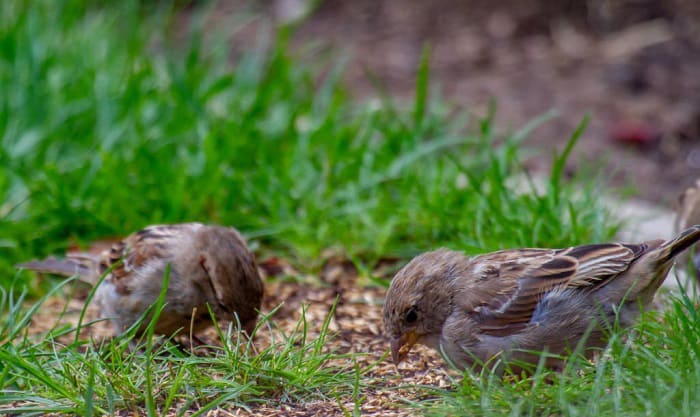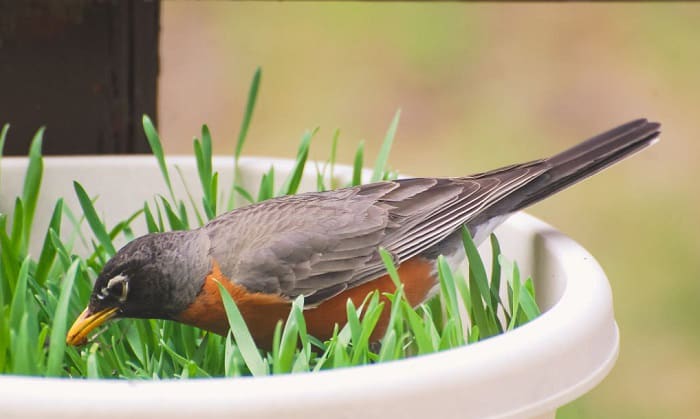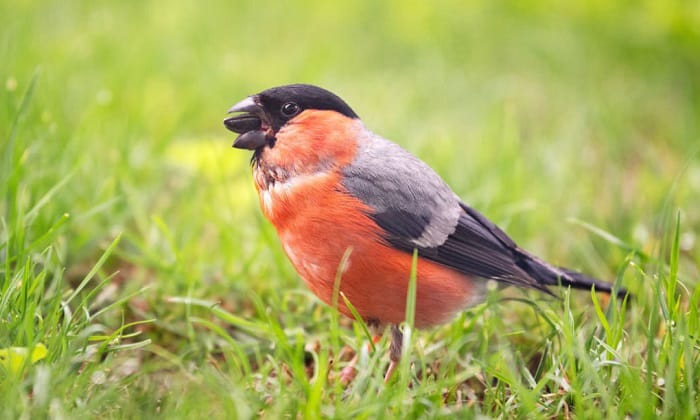Waking up with the songs of the adorable birds is absolutely divine. They’re perfect for photography inspiration as they serenade your garden. Plus, you’re fond of the avian species, that’s why you have feeders and birdbaths. But as fascinating as these flying creatures are, they’re a nightmare to your grass seeds.
So how to keep birds from eating grass seed and allow your lawn to cultivate beautifully? There are a couple of methods. But the main thing is, you need to create protection for the grass seeds. And all tactics we feature are, of course, safe for the birds.
Table of Contents
- Materials Needed to Keep Grass Seeds Safe From Birds
- 12 Effective Methods on Keeping the Birds From Munching on Grass Seeds
- Method #1: Utilize netting
- Method #2: Use homemade bird repellent solution
- Method #3: Plant toy windmills
- Method #4: Hang bird tape
- Method #5: Install aluminum foil strips
- Method #6: Cover ground with mulch
- Method #7: Use burlap sheets
- Method #8: Place fake predator decoys
- Method #9: Dangle wind chimes on poles
- Method #10: Put a motion sprinkler
- Method #11: Utilize ultrasonic avian repeller
- Method #12: Lure birds to a feeder
- Helpful Tips on How to Save Grass Seeds From Birds
- Conclusion
Materials Needed to Keep Grass Seeds Safe From Birds
To successfully keep the birds from disrupting your lawn concept, you should prepare some of the pieces below, whichever is the easiest to get.
- Polyurethane net
- Stones
- Four short poles
- Four short ropes
- Windchimes
- Poles
- Fake predator decoys
- Ultrasonic bird repeller
- 48 pieces of chili pepper
- Container
- Water
- Spray bottle
- Apple cider vinegar
- 4 teaspoons cayenne pepper
- Aluminum foil strips
- Toy windmills
- Bird tape
- Stakes
- Rake
- Burlap sheet
- Wire U pins
12 Effective Methods on Keeping the Birds From Munching on Grass Seeds
It’s no secret that birds love seeds, and grass seeds are no exception. And when you’re working on making your lawn more beautiful with freshly grown grass, the passerine species could be a major threat to your goal.
When left unprotected, the grass seeds can become the next meal for the visiting birds. So the question on every homeowner’s mind is, how to stop birds from eating grass seed?
Here’re some easy methods for preventing birds from disturbing your lawn progress.
Method #1: Utilize netting
Following a process of netting to protect grass seed from birds is an ideal solution to an undisturbed lawn.
It is best to choose a polyurethane material for the net since they are resistant to mold or mildew. This kind of netting is super light, making it perfect for preventing birds from munching on your grass seeds.
What you need to do is purchase a netting product that can cover the size of your lawn.
- Place the net over the planted grass seeds.
- For good measure, you can erect four short poles at every corner of the net to create a space between the ground and the cover.
- Tie the corners of the net on the poles using short ropes.
- Allow the hem to flow to the ground for full coverage.
- Top the edges with stones for extra security.
Method #2: Use homemade bird repellent solution
To prevent birds from eating grass seeds, an excellent method is to use a bird repellent solution. There are homemade bird repellent sprays that you can create on your own.
- Chilli Pepper Solution – in a container, mix crushed 48 pieces of chilli peppers and one gallon water.
- Allow the mixture to ferment for 3-5 days under the sun, and add 1 cup of apple cider vinegar. Transfer the solution to a spray bottle.
- Cayenne Pepper Solution – use a container to combine one gallon of water, half a dozen drops of liquid detergent, and 4 teaspoons of cayenne pepper.
- Leave the mixture for 2-4 days, mix well, and then transfer to a spray bottle.
These two homemade bird repellent solutions are super effective in driving the passerine species away from your lawn. Simply spray either of the solutions on your lawn where you sown the grass seeds. Reapply the mixture daily.
Method #3: Plant toy windmills
Toy windmills are children’s happiness, and they are also tools for scaring birds. Fast-whirling objects deter the passerines, so using windmills is a terrific idea. As for your grass seed, birds won’t eat them if they see a bunch of whirling toys on your lawn.
- Simply plant the windmills on your lawn where the grass seeds are planted.
- Just make sure to allow at least two feet of space between each toy.
- Once the grass seeds are grown, you can gently remove all the windmills.
Method #4: Hang bird tape
Bird tape is an excellent solution for keeping avians away from your lawn. It is crafted with flashy reflective materials. And combined with a crinkling tune, the passerine species will surely fly away from your grass seeds.
- You can attach the bird tape to trees or fences near your lawn.
- Or push a couple of stakes on the ground and use them to install the bird tape.
The good news is that this product can last for up to 8 weeks, and the grass seeds grow within 5-10 days only.
Method #5: Install aluminum foil strips
Aluminum foil is a natural deterrent that avians hate.
- Use this knowledge to your advantage by cutting strips of aluminum foil and placing them barely underneath the soil.
- When the birds start to peck on the grass seeds, they will stop immediately once they feel the aluminum foil on their bills.
- Another method to use this product is to hang the strips on a tree or fence near the newly sown lawn. The avian species detest the glare and would surely stay far away from your grass seeds.
Method #6: Cover ground with mulch
To protect grass seed from birds, another good idea is:
- Spread a thin layer of straw mulch above the soil. This process allows the soil to retain its moisture, and supports the proper germination of seeds.
- Also, using mulch blocks the rise of weeds, which is surely helpful in the growth of your lawn grass.
- Once the new grass has grown, simply remove the mulch carefully from the lawn using a rake. The removal process must be done gently and with utter attention. Make sure that the grass is not damaged in any way.
Method #7: Use burlap sheets
If your area is prone to strong winds, then the use of burlap sheets is definitely what your newly sown lawn needs. This product is perfect for creating the best germination condition. Plus, the birds cannot see the bird seeds through the sheets.
- To prevent wind from blowing the burlap sheets away, use a couple of wire U pins to attach the edges to the ground.
- And to save money, you can purchase rolls of burlap that are enough to cover the sown lawn.
- Once germination is done, simply remove the burlap sheets.
Method #8: Place fake predator decoys
The avian species naturally fear their typical predators such as hawks, owls, larger birds, and cats. They usually stay clear from areas these animals visit frequently, so use them to save your lawn from hideous patches.
Place a couple of fake animal decoys on your lawn to scare the passerines away. However, make it a point to interchange the placements of the predator decoys.
Keep in mind that if the birds notice that the location of the animals is the same, they will find out that they are fakes.
Method #9: Dangle wind chimes on poles
Your freshly seeded lawn deserves to be free from bird eating grass seed.
- And to make sure that no avians are lunching on your grass seeds, place a couple of wind chimes around your lawn.
- If there are no trees or fences nearby, install poles and hang the wind chimes at least three feet from the ground.
All birds are deterred by motions and sounds from shiny objects, and wind chimes produce both. There is no limit to how many products you hang, as long as they can cover the whole lawn with their sound.
Method #10: Put a motion sprinkler
The newly planted grass seeds require enough moisture to germinate. By installing a motion-activated sprinkler on your lawn, the seeds get the water they need, and at the same time frighten the birds.
When the passerines land on the lawn, the sprinkler will start running, which will scare the intruders away.
This product also emits sound, and birds hate that. Indeed, by opting for this method, you :” kill two birds with one stone”, per se.
Method #11: Utilize ultrasonic avian repeller
With a coated grass seed, birds are not likely to munch on your lawn. However, these seeds are more expensive and take longer to grow. And so, if you want to forgo using this kind of product, then it’s best to turn to an ultrasonic passerine repeller.
This product usually comes with a stake, so it’s seamless to install on your lawn. The ultrasonic repeller generates a high-pitched sound that can be heard only by the birds. By playing this annoying sound all day, the birds will not come near your lawn.
Method #12: Lure birds to a feeder
A bird repellent grass seed makes a lot of sense, but using them costs more. Plus, they require longer days to germinate.
One good way to lure the birds away from your newly seeded lawn is to divert the attention of the passerines to your bird feeder.
By feeding the avians with high-quality bird seeds, earthworms, fruits, jellies, nuts, and other favorite foods of avians, the visiting passerines will leave your lawn alone.
The idea is, that if the birds have access to a good food source, then they will not munch on grass seeds.
Helpful Tips on How to Save Grass Seeds From Birds
Birds can make people happy, as long as they stay in the side of your yard where they can’t disturb your freshly seeded lawn. Let’s look at a couple of tips on making this happen.
- Baking soda is a good bird repellent, but never use this kitchen product on your lawn. It can kill your grass seeds, which absolutely contradicts your goal to grow new grass on your property.
- If you opt for a bird tape, a 6-8 feet length of strips is perfect for your lawn. Make it a point to hang the bird tape closer to the ground so the avian species are deterred easily.
- Using mulch is a great idea to deter birds from your lawn. However, there are alternatives that you can use too.
- Spread 1/4 inch of sawdust above the sown lawn.
- Apply peat moss on top of the lawn but make sure to provide enough space for water to penetrate the soil.
- A 1/4 inch layer of compost can not only keep the grass seeds safe for birds, but they help in fertilization too.
- If you want to avoid using covers or repellents altogether, you can choose to plant coated grass seeds on your lawn. This kind of seed leaves a nasty taste on the birds, so they will not munch on your lawn.
Conclusion
Birds are no doubt a major pain when you sow your grass seeds on your lawn. These beautiful creatures are a sight for sore eyes, but they pose a massive threat to your lawn. Fortunately, we have featured the best methods on how to keep birds from eating grass seed.
The primary idea is to cover the lawn, spray bird repellent solutions, or install deterrent objects to keep the passerines away.
We hope we’ve provided new information for you. Kindly share this post with your social media and friends.
Furthermore, refer to our article about methods to get birds out:

George and I became friends after a birdwatching trip with our new group. And we have been enjoying every adventure together. When he told me the idea of establishing a site that shares our experiences and fun, I immediately agreed. After trials and errors, here we have Thayerbirding.
















